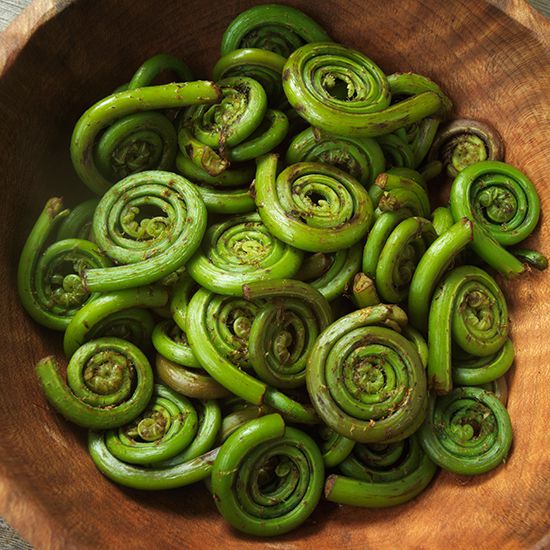

Diplazium esculentum (Retz.) Sw.
|
It is commonly known as Lingad, a fern vegetable. It belongs to the family Athyriaceae. The young tender fronds are stir-fried. It has a number of bioactive compounds like Lutein, Phytol, Quercetin, Pterosin B, Sabinene, Apgenin, α- Linolenic acid, α -Pinene, β- ocimene, Pinene, and Ponasterone A. Both raw and boiled forms of D. esculentum contains potent immunosuppressive activities as evident by Th1/Th2 cytokine imbalance. Mode of Consumption : Boiled and stir fried |
| Plant Details | Agro-climatic Zone | Vernacular Names | Pictures |
| Scientific Name: Diplazium esculentum (Retz.) Sw. Family: Aspleniaceae Newman Class: Polypodiopsida Order: Polypodiales Genus: Diplazium Sw. Fruiting Season: March -July (Himachal) June-September (Assam) Parts: Tender fronds |
|
Arunachal Pradesh : Takang, Pu kut Dhekia, Kukuling, Lochanch Assam : Dhekia Saag Himachal Pradesh : Lingad, Lingra Jammu & Kashmir : Kasrot Mizoram : Mrang khowa Sikkim : Ningro Tripura : Cluli Uttarakhand : Linguda, Lingru West Bengal : Dhenkir Shaak |
 Bundle of tender fronds  Tender fronds |
| Compound/Extract | Activity | Mode of Action | Marker/References |
| Extract | Anti-inflammatory | Extracts stabilized the mast cell membrane and inhibited the production of nitric oxide synthase (NOSs) resulting in a decreased level of nitric oxide in both serum and peritoneal fluid. | NOSs[1] |
| Hydroalcoholic leaf extrac | Antioxidant | Hydroalcoholic leaf extract suppresses the production of Nitric oxide in the cells. | NO[3] |
| Aqueous extract | Neurostimulating | Aqueous extract stimulated the CNS function in mouse. | [7] |
| Chloroform and acetone extracts | Anti-inflammatory | Chloroform and Acetone extracts at a dose of 100 mg/kg showed significant reduction in the Carrageenan induced paw edema in rat. | [8] |
| Major Class | Metabolites (Content of bioactives: mg/100g Fresh Weight) |
| Acid anhydride | Phosphoric acid: [6] |
| Alcohol | 10,12-Hexadecadien-1-ol: , 1-Heneicosanol: [6] |
| Alkene | Neophytadiene: [5] |
| Carboxylic Acid | 1,2- Benzenedicarboxylic acid: , Acetate: , Diisobutyl phthalate: , Phthalic acid: , Protocatechuic acid: , trans-Cinnamic acid: [5] |
| Carotenoid | Lutein: [6] |
| Ecdysteroid compound | Makisterone C: [5] |
| Fatty acid | 5,8,11,14-Eicosatetraenoic acid: , Hexadecanoic acid methyl ester: , Pentadecanoic acid: [6] |
| Flavonoid | Quercetin: [6] |
| Indene | Pterosin B: 1.094 - 1.636 mg/100g[6] |
| Palmitic Acid | Methyl palmitate: [5] |
| Phytosterol | Ponasterone A: , Stigmast-5-en-3-ol, (3β): [6] |
| Steroid | Amarasterone A1: , Ergost-5-en-3-ol, (3β): [6] |
| Sugar | Phytic acid : 0.3[9] |
| Terpene | Caryophyllene oxide: , Esculentic acid: , Phytol: , Ptaquiloside: , α-Pinene: , β-ocimene: [6] |
| Terpenoid | 1,8-Cineole: [5] |
| Vitamin | Ascorbic acid: [5] |
| Effect | Observation | DOI |
| Disease | Formulation | Reference | Author | TKDL |
| Information from Wealth of India | Reference |
|
CSIR(1952).The Wealth of India, Raw materials,Vol.-III ,P.87-88, New Delhi, India |
| 4.2, 4.2.1, 4.2.1.1, 4.2.1.3, 4.2.2.8 |
|
| CSIR-North East Institute of Science and Technology, Jorhat-6, Assam, India
CSIR-Institute of Himalayan Bioresource Technology, Palampur-61,Himachal Pradesh, India |